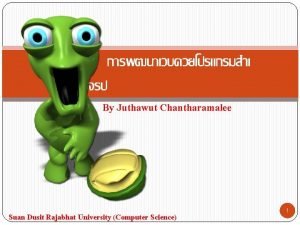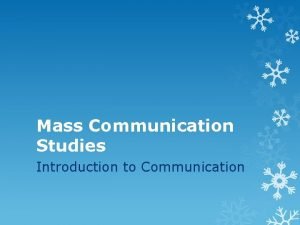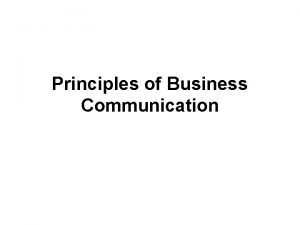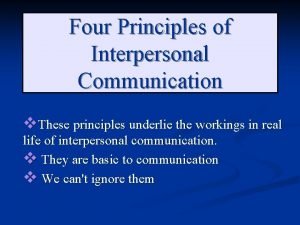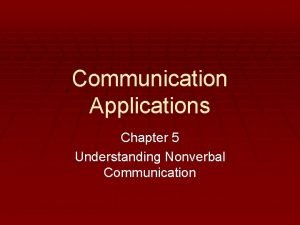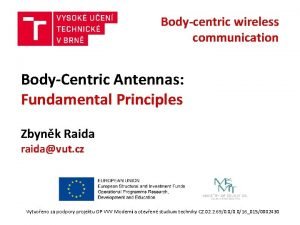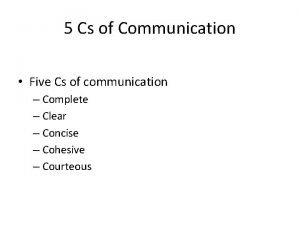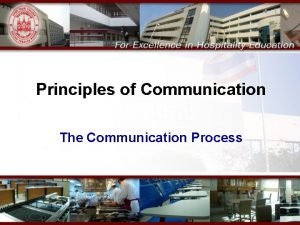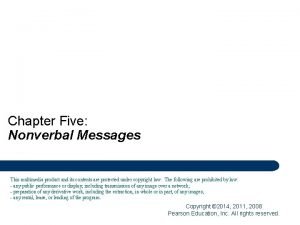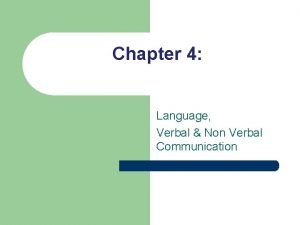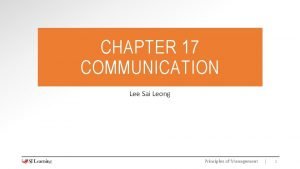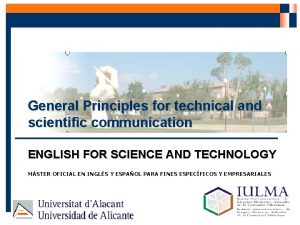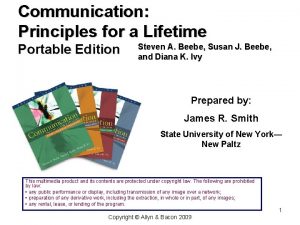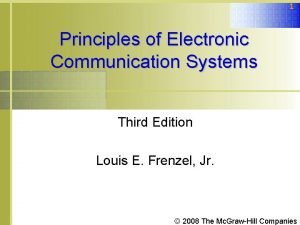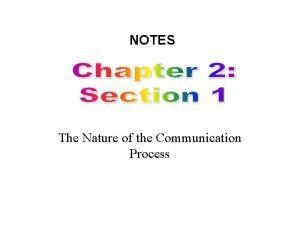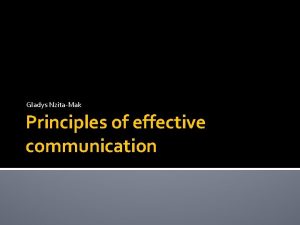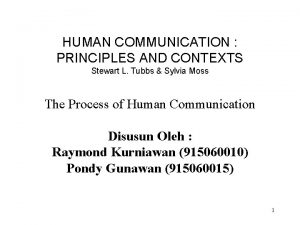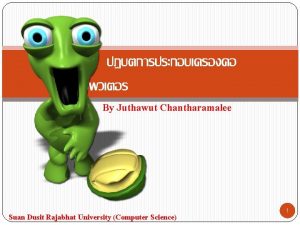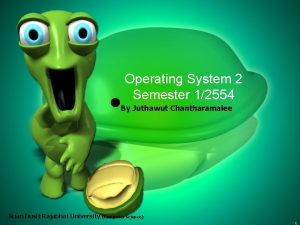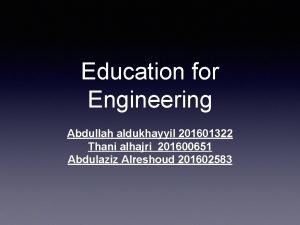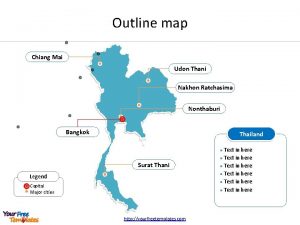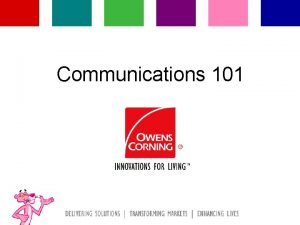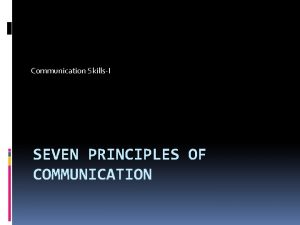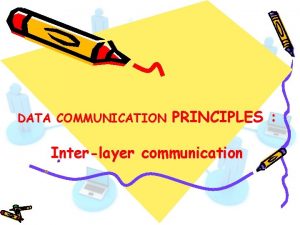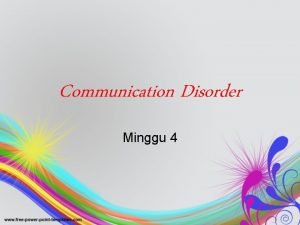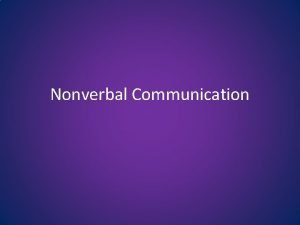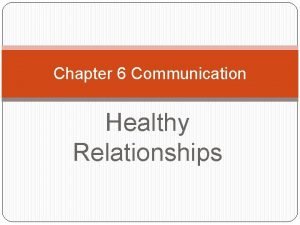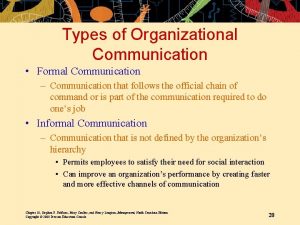Dusit Thani College Principles of Communication Principles of

































- Slides: 33

Dusit Thani College Principles of Communication

Principles of Communication Unit 1: Fundamentals of Communication Arj. Zeph Norrish

Objectives Following this class you will be able to: • Describe language as a mechanism of communication • Describe developments in the study of language • Understand use a range of linguistic terms • Discuss relationships between language and culture • Consider implications for the Hospitality Industry

1. 4 The Definition of Language The word ‘language’ can have different meanings: • The concept of collecting and sending of information • A system for those concepts; like French, English, Thai • A formal system of rules of grammar • A mechanism for communication • A system for cooperation • The infinite set of utterances for finite elements; animals don’t have this ability

World Languages http: //people. umass. edu/~nconstan/201/Language%20 Families%20 World%20 Map. png


World Languages http: //www. everytongue. com/list 1 -on-line-recordings. htm

1. 5 The Study of Language • Linguistics, has been developing into a science for more than 2000 years… …from Pāṇini’s ‘Sanskrit’… …to Sibawayh’s ‘Al-kitab fi al-nahw’… …to Plato’s ‘Cratylus dialogue’

1. 6 Language and Its Parts • Language has three parts: signs, meanings, and codes and is analyzed through the following studies: • Semiotics = how signs and meanings are used • Syntax = the grammar rules of a system • Semantics = meaning of the signs, words, phrases • Specific signs are assigned to show those meanings easier…

1. 6 Language and Its Parts • Phonology studies how we create meaning • Phonetics studies how we form sounds • Those sounds are phonemes, or syllables: • Vowels • Consonants

Phonetics for English Consonants (IPA)

Phonetics for Thai Consonants (IPA)

Phonemes - Vowel Sounds Short vowel sounds use single vowels b bilabial plosive e o u a i a t /æ/ dental plosive Long vowel sounds use combinations of vowels n i c e / aɪ /

Phonemes - Vowel Sounds Long vowel sounds use combinations of vowels n i c e r i d e Alternative spellings: f r i e d (same sound) / aɪ / f i g h t h e i g h t c r y

Quick Game On the sheet provided: 1. Write as many words as you can using the LONG VOWEL sound provided. 2. Think of different ways to spell the sound and write as many words using these spelling 3. For a bonus point, write a sentence using as many of these words as you can Fay and Jane play on the same day. Nope! I won’t throw the toad! Eve needs to see the team. The cute blue goose flew to the moon.

Considerations / Restrictions We have seen many vowel and consonant combinations (phonemes). However, the construction of English does provide limitations. For example: /ŋ/, as in sing, occurs only at the end of a syllable, never at the beginning such as in Thai ( ngu – snake – ง , or ngoen – money – เงน ) /h/ occurs only before vowels and at the beginning of a syllable, never at the end (a few languages, such as Arabic, or Romanian allow /h/ syllable-finally) Anomalies tough dough cough bow

1. 6 Language and Its Parts • Morphemes are meaningful elements in a language. They can either be FREE or BOUND. If they are FREE, they are called WORDS. If they are BOUND, they are called AFFIXES. Two types: PREFIX Positioned BEFORE a word SUFFIX Positioned AFTER a word COMBINATIONS dis satisfy ing

1. 6 Language and Its Parts • The rules for this use of morphemes is called morphology… WORD AFFIXES (suffixes) • Syntax then gives rules for using multiple morphologic forms in a statement structure.

1. 6 Language and Its Parts Grammar is the study of the SYSTEM of languages. It provides RULES for combining MORPHEMES to create further meaning, through PHRASES and SENTENCES. We then use word classes (or parts of speech) for those grammar rules… such as nouns (the subject of a statement) and verbs (the action). Sally runs. subject predicate (verb) intransitive (no object) Sally throws a ball. subject verb object transitive (has object)

1. 6 Language and Its Parts Syntax “the way that words and phrases are put together to form sentences in a language; the rules of grammar for this” Oxford Advanced Learner’s Dictionary Determiner: ‘used to qualify nouns’ e. g. , the, a, his, your, two, etc.

Syntax Activity Noun Phrase (subject) You will be given a complete sentence structure. You must identify/position the ‘syntactic’ components. Using the shaded vocab cards, create a meaningful sentence.

Syntax Activity Sentence Verb Phrase (predicate) Noun Phrase (subject) DET Determiner V Verb N Noun DET Determiner The father saw ADV Adverb NP Noun Phrase his son N Noun instantly PP Prepositional Phrase PREP Preposition at NP Noun Phrase DET Determiner N Noun the market

1. 7 Language and Culture • • Language and culture are very closely intertwined. We perceive only what our language allows us. Our language controls our world view. Speakers of different languages have different world views. • Studies of language and culture consider: • Socio-linguistics • Ethno-linguistics • Linguistic Anthropology

1. 7 Language and Culture Humans use language as a way of signaling identity with one cultural group and difference from others. Languages do not differ only in pronunciation, vocabulary and grammar but also ‘speaking cultures’. Language practice can be used based on cultural norms: social class gender age education ‘kinship’ rank

1. 7 Language and Culture They connect for speech and behavior, like… • Formal Conversation (“Yes, I would like some water. ”) • Informal Conversation (“Yeah, gimme some water. ”) • Slang (“Yo! I’m dyin of thirst o’er ere!”) • Hierarchy Vocabulary (“Nong Wit” or “Pee Wit”) • Gender (“Krup” or “Ka”) Communication must be adapted in order to be understood.

1. 7 Language and Culture The Hospitality Industry provides for MORE LANGUAGES AND CULTURES exposure and experience than ANY other! So, it is ESSENTIAL that YOU MAXIMISE YOUR UNDERSTANDING

Summary Today you have learned how to: • Describe language as a mechanism of communication • Describe developments in the study of language • Understand use a range of linguistic terms • Discuss relationships between language and culture • Consider implications for the Hospitality Industry

BREAK! • Now, take a 30 -minute break and then return to the class to work on your hand-out. Take a break

Handout Review • You will now be given a handout with comprehension question • Use the book and the notes you’ve taken to answer the questions as best as possible. • You have 45 -minutes to complete the handouts and return them to the instructor at the end of class.

HOMEWORK! Read Unit 2 and complete sections 2. 1 Key Vocabulary and Chapter 2 Review: Case Study.



 Dusit thani meaning in english
Dusit thani meaning in english Suan dusit rajabhat university
Suan dusit rajabhat university Wake tech admissions
Wake tech admissions Early college high school at midland college
Early college high school at midland college Parallel bus vs serial bus
Parallel bus vs serial bus What is oral communication and written communication
What is oral communication and written communication Serial and parallel interface in microprocessor
Serial and parallel interface in microprocessor Different types of mass communication
Different types of mass communication Meaning of oral communication
Meaning of oral communication Serial communication vs parallel communication
Serial communication vs parallel communication Therapeutic communication characteristics
Therapeutic communication characteristics Principles of electronic communication systems 3rd edition
Principles of electronic communication systems 3rd edition Principles of communication correctness
Principles of communication correctness Interpersonal communication is irreversible
Interpersonal communication is irreversible What are the principles of nonverbal communication
What are the principles of nonverbal communication Fundamental principles of wireless communication
Fundamental principles of wireless communication Explain 5 c's of communication
Explain 5 c's of communication Intermediary/gatekeeper model of communication example
Intermediary/gatekeeper model of communication example Verbal communication principles
Verbal communication principles Oculesics
Oculesics 17)principles of communication-------
17)principles of communication------- Principle of supportive relationship
Principle of supportive relationship Principles of science
Principles of science Rent communication principles for a lifetime
Rent communication principles for a lifetime Business communication module
Business communication module Principles of electronic communication systems 3rd edition
Principles of electronic communication systems 3rd edition Communication is unavoidable
Communication is unavoidable Principle of effective communication
Principle of effective communication Human communication principles and contexts
Human communication principles and contexts Zeal dnyanganga college of engineering and research
Zeal dnyanganga college of engineering and research Reggio curriculum
Reggio curriculum Woodland community college counseling
Woodland community college counseling Crossroads international church singapore
Crossroads international church singapore Anisa ali
Anisa ali

